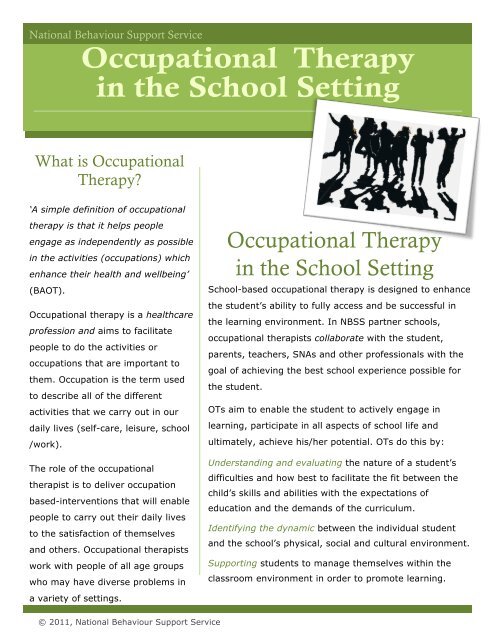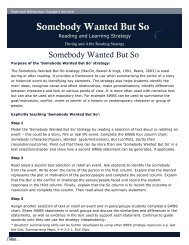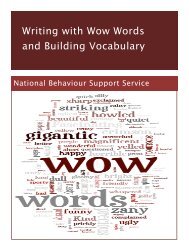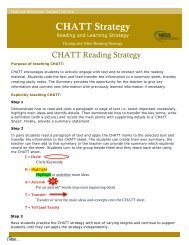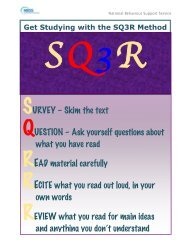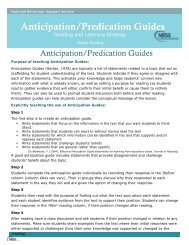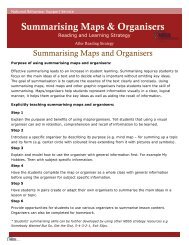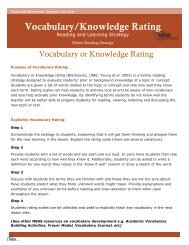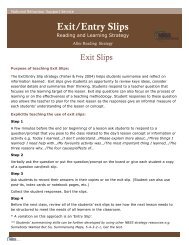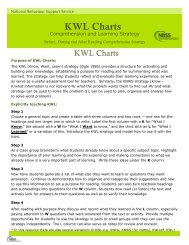View/Download PDF - NBSS
View/Download PDF - NBSS
View/Download PDF - NBSS
You also want an ePaper? Increase the reach of your titles
YUMPU automatically turns print PDFs into web optimized ePapers that Google loves.
National Behaviour Support Service<br />
Occupational Therapy<br />
in the School Setting<br />
What is Occupational<br />
Therapy?<br />
‘A simple definition of occupational<br />
therapy is that it helps people<br />
engage as independently as possible<br />
in the activities (occupations) which<br />
enhance their health and wellbeing’<br />
(BAOT).<br />
Occupational therapy is a healthcare<br />
profession and aims to facilitate<br />
people to do the activities or<br />
occupations that are important to<br />
them. Occupation is the term used<br />
to describe all of the different<br />
activities that we carry out in our<br />
daily lives (self-care, leisure, school<br />
/work).<br />
The role of the occupational<br />
therapist is to deliver occupation<br />
based-interventions that will enable<br />
people to carry out their daily lives<br />
to the satisfaction of themselves<br />
and others. Occupational therapists<br />
work with people of all age groups<br />
who may have diverse problems in<br />
a variety of settings.<br />
Occupational Therapy<br />
in the School Setting<br />
School-based occupational therapy is designed to enhance<br />
the student’s ability to fully access and be successful in<br />
the learning environment. In <strong>NBSS</strong> partner schools,<br />
occupational therapists collaborate with the student,<br />
parents, teachers, SNAs and other professionals with the<br />
goal of achieving the best school experience possible for<br />
the student.<br />
OTs aim to enable the student to actively engage in<br />
learning, participate in all aspects of school life and<br />
ultimately, achieve his/her potential. OTs do this by:<br />
Understanding and evaluating the nature of a student’s<br />
difficulties and how best to facilitate the fit between the<br />
child’s skills and abilities with the expectations of<br />
education and the demands of the curriculum.<br />
Identifying the dynamic between the individual student<br />
and the school’s physical, social and cultural environment.<br />
Supporting students to manage themselves within the<br />
classroom environment in order to promote learning.<br />
© 2011, National Behaviour Support Service
National Behaviour Support Service<br />
How Do OTs Support Students?<br />
All occupational therapy interventions are guided<br />
by evidence based theoretical models and<br />
frameworks e.g. Person-Environment-Occupation<br />
(P.E.O.) model and the Sensory Integration Theory.<br />
Individual Work<br />
Individual therapy sessions address occupational<br />
performance areas of concern. Areas of intervention can<br />
address:<br />
• Organisation skills<br />
• Sensory regulation<br />
strategies<br />
• Handwriting<br />
Group Work<br />
The aim of group work is to develop a positive peer<br />
culture through a supportive group environment, which<br />
fosters engagement and participation and enables the<br />
students to develop and practice positive interpersonal<br />
skills such as:<br />
• Listening<br />
• Turn taking<br />
• Problem solving<br />
• Team work<br />
© 2011, National Behaviour Support Service<br />
• Respect & responsibility<br />
• Choice<br />
• Equality<br />
Occupational<br />
Performance<br />
• Balance &<br />
coordination<br />
• Positive self image<br />
(Law et al., 1996)<br />
• Anxiety management<br />
• Self care issues<br />
What are Sensory<br />
Integration Difficulties?<br />
Students who have decreased ability<br />
to process sensation also may have<br />
difficulty producing appropriate<br />
actions, which interfere with learning<br />
and behaviour. Signs of sensory<br />
integration difficulties can include:<br />
• Over/under response to touch,<br />
sound, vision, smell,<br />
movement and taste.<br />
• Easily frustrated/aggressive.<br />
• Distractible.<br />
• Difficulties with<br />
transitions/new situations.<br />
• Delayed motor skills<br />
(fine/gross).<br />
• Unusually high/low activity<br />
levels.<br />
• Problems with social<br />
interactions.<br />
What can be done to help?<br />
Identify the challenges that children<br />
with sensory regulation problems<br />
encounter in everyday life and in<br />
particular, in school.<br />
Adapt the environment or<br />
activity/task to suit the student’s<br />
sensory needs.<br />
Empower the student to self regulate<br />
his/her arousal level to suit the<br />
situational demands.<br />
2
National Behaviour Support Service<br />
How Do OTs Support Students?<br />
The ALERT Program<br />
Occupational therapists in <strong>NBSS</strong> partner schools also use<br />
the international evidence-based ALERT Program ‘How<br />
Does Your Engine Run’ (Williams & Shellenberger, 2008).<br />
The programme aims to help students learn to monitor,<br />
maintain and change their level of alertness so that it is<br />
appropriate to situation or task.<br />
Through activities and discussions, the programme<br />
identifies the students’ sensory needs/preferences and<br />
encourages the use of sensory motor strategies to support<br />
self regulation so students’ engines are running ‘just<br />
right’. The strategies and activities can be incorporated<br />
into home and school routines.<br />
Environmental Audit<br />
OTs understand the important impact of environmental<br />
factors on students.<br />
The demands of a secondary school dictate that a student<br />
must negotiate a busy and often overwhelming<br />
environment on an hourly basis.<br />
OTs are trained to assess a school’s physical & sensory<br />
environment and make recommendations for suitable<br />
alterations in order that students feel safe and<br />
comfortable accessing their classrooms.<br />
Recommendations/Interventions would address:<br />
• Classroom layout.<br />
• Applying universal access guidelines.<br />
• Way-finding techniques such as colour coding &<br />
signage.<br />
• Advising on lighting & acoustic adaptations to<br />
create a calm environment.<br />
• Design of inclusive, social & recreational spaces.<br />
Occupational therapy interventions are more effective<br />
when integrated into the daily routines of the school and<br />
classroom environments.<br />
© 2011, National Behaviour Support Service<br />
3
National Behaviour Support Service<br />
Details of the New Post Primary<br />
School-based Occupational Therapy Service<br />
This information leaflet for teachers and schools was<br />
written by Brian Fitzgerald, Carolyn Lanigan O'Keeffe and<br />
Dr. Siobhan MacCobb, the Discipline of Occupational<br />
Therapy, Trinity College, Dublin.<br />
Brian FitzGerald and Carolyn Lanigan-O’Keeffe, are<br />
employed by the National Behaviour Support Service<br />
(<strong>NBSS</strong>) and the Discipline of Occupational Therapy,<br />
Trinity College. Both are graduates of the Discipline of<br />
Occupational Therapy, Faculty of Health Sciences, Trinity<br />
College and are members of the Association of<br />
Occupational Therapists of Ireland (AOTI).<br />
References<br />
Ayres, A.J. (1979). Sensory integration and the child. Los Angeles:<br />
Western Psychological Services.<br />
British Association Of Occupational Therapists and College of<br />
Occupational Therapists (BAOT). http://www.cot.co.uk<br />
Bundy, A. C., Lane, S. J., & Murray, E. A. (2002). Sensory<br />
integration: Theory and practice. Philadelphia: F. A. Davis.<br />
Law, M., Cooper, B,. Strong, S., Stewart, D., Rigby, P. & Letts, L.<br />
(1996). The Person-Environment-Occupation Model: A transactive<br />
approach to occupational performance. Canadian Journal of<br />
Occupational Therapy. 63(1):9-23<br />
Williams, M.S. and Shellenberger, S. (2008). Alert Program ‘How<br />
Does Your Engine Run’. Therapy Works, Inc.<br />
.<br />
© 2011, National Behaviour Support Service<br />
4


